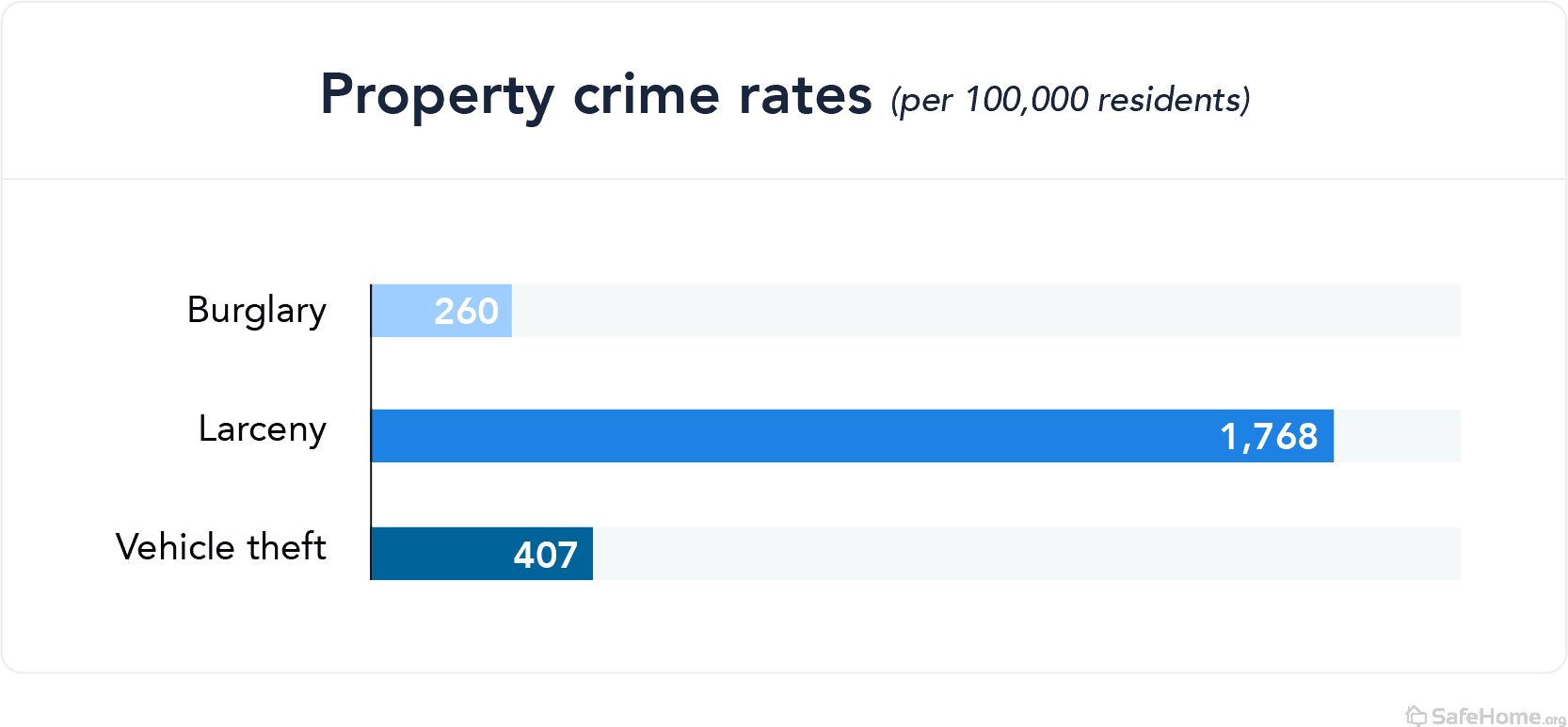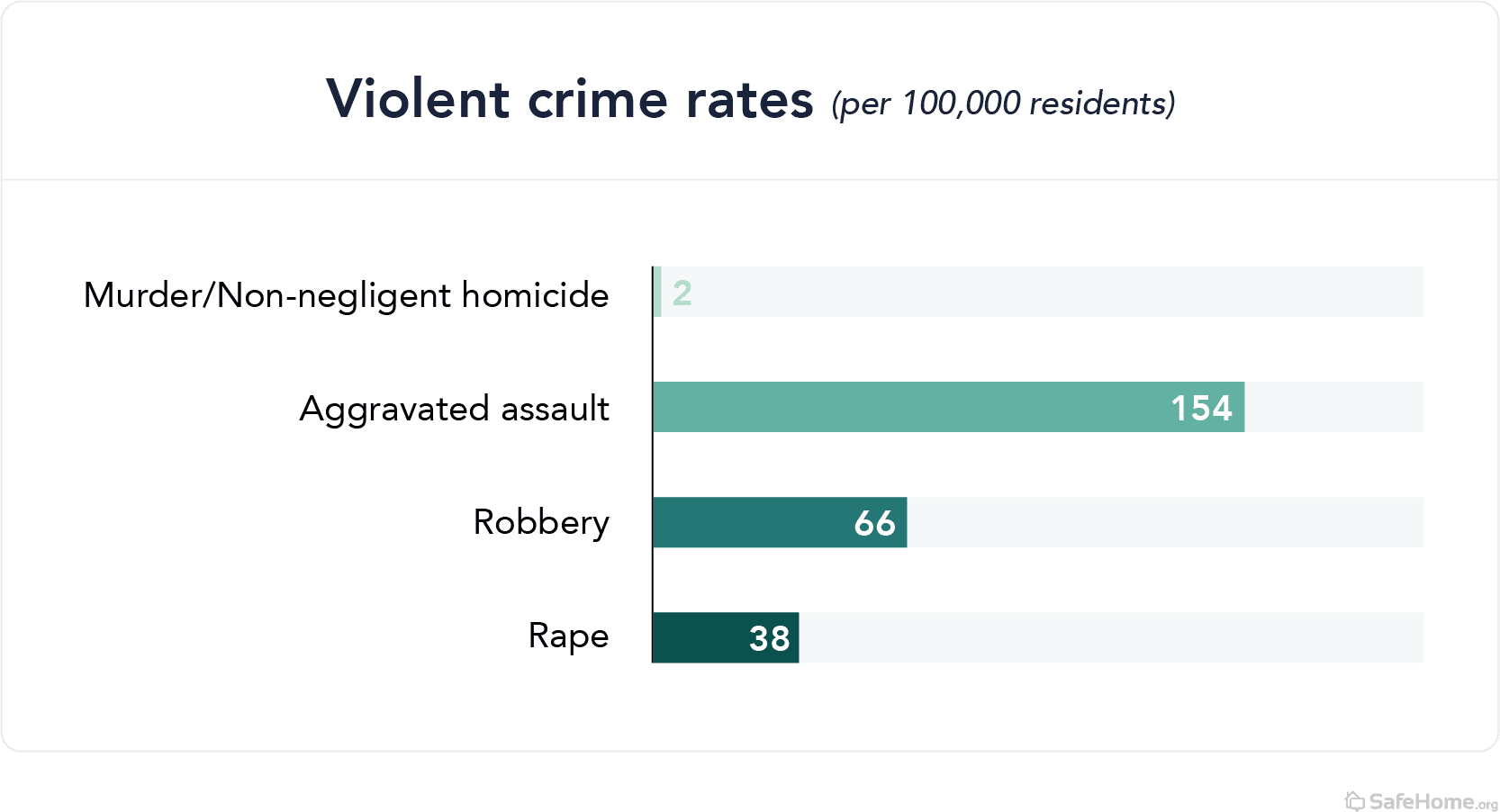The Safest and Most Dangerous Cities in Hawaii

Hawaii ranks seventh among all states for its property crime rate, according to data from the FBI. Its rate is about one-quarter higher than the overall national rate for crimes like burglary and auto theft.
However, a discussion of Hawaii’s crime rates would be incomplete without acknowledging the fact that tourism is central to Hawaii’s economy. Even after the COVID-19 pandemic put a damper on tourism, Hawaii had more than 9 million visitors in 2022.1 The state’s permanent population is less than 1.5 million; this makes it easy to see why crimes like larceny-theft would push Hawaii near the top of the list for property crime in a population-adjusted analysis.
Property Crime in Hawaii
When determining property crime rates in Hawaii, we looked at larceny-theft, burglary, and motor vehicle theft incidents.
- Hawaii’s total property crime rate per 100,000 people is 2,435, which is 25 percent higher than the overall U.S. rate of 1,954 per 100,000; the state ranks seventh among all 50 states.
- Larceny continues to be the most common property crime in Hawaii, as it is everywhere else in the country, with about 1,768 incidents per 100,000 people:
Violent Crime in Hawaii
Violent crimes include murder/non-negligent manslaughter, aggravated assault, rape, and robbery; the state’s rate in these types of crimes is much lower than its property crime rate.
- Hawaii’s violent crime rate is 260 per 100,000 people, which is more than 30 percent lower than the overall national rate of 381 per 100,000.
- The state ranks 37th among all 50 states for violent crime, and its rate of murder/non-negligent manslaughter is tied for sixth lowest with Massachusetts.
- Aggravated assault is the most common type of violent crime in Hawaii, and murder is the least common.
Crime in Hawaii Cities
Municipal-level data for Hawaii communities is limited to the two metro areas in the state: Honolulu and Kahului. For the most part, neither metro area ranks among the top 300 metro areas in the country, though they both have above-average rates of larceny and motor vehicle theft; Honolulu ranks in the top 100 for robbery.
Hawaii metro area crime rates per 100,000 people (rank among 300+ metro areas)
| Metro area | Violent crime (overall) | Murder/non-negligent manslaughter | Rape | Robbery | Aggravated assault | Property crime (overall) | Burglary | Larceny-theft | Motor vehicle theft |
|---|---|---|---|---|---|---|---|---|---|
| Kahului-Wailuku-Lahaina | 308 (194th) | 3 (225th) | 34 (231st) | 31 (192nd) | 240 (174th) | 2811 (37th) | 295 (139th) | 2038 (38th) | 479 (24th) |
| Urban Honolulu | 253 (231st) | 3 (239th) | 30 (256th) | 84 (41st) | 137 (259th) | 2578 (64th) | 264 (169th) | 1850 (62nd) | 465 (27th) |
Our data
Our data comes from comprehensive reporting compiled by the FBI and accessed via the Crime Data Explorer website. Property and violent crime state figures were drawn from Table 5 of the 2022 Crime in the U.S. Report. Metropolitan figures were found in Table 6, Crime in the U.S. by Metropolitan Statistical Area. The population figures in that table are U.S. Census Bureau provisional estimates as of July 1, 2020.
Limitations: According to the FBI, the data in the publication tables may differ from those released on the Explorer Pages of the CDE. These variations are due to the difference in methodologies between the publication tables and data displayed on the CDE. Please note that crime statistics are not the sole measure of a city’s safety.
Navigate Crime Data by State
- Alabama
- Alaska
- Arizona
- Arkansas
- California
- Colorado
- Connecticut
- Delaware
- Florida
- Georgia
- Idaho
- Illinois
- Indiana
- Iowa
- Kansas
- Kentucky
- Louisiana
- Maine
- Maryland
- Massachusetts
- Michigan
- Minnesota
- Mississippi
- Missouri
- Montana
- Nebraska
- Nevada
- New Hampshire
- New Jersey
- New Mexico
- New York
- North Carolina
- North Dakota
- Ohio
- Oklahoma
- Oregon
- Pennsylvania
- Rhode Island
- South Carolina
- South Dakota
- Tennessee
- Texas
- Utah
- Vermont
- Virginia
- Washington
- West Virginia
- Wisconsin
- Wyoming
Citations
- State of Hawaii. 2022 Annual Visitor Research Report
https://files.hawaii.gov/dbedt/visitor/visitor-research/2022-annual-visitor.pdf


